adding oil AUDI A5 COUPE 2011 Owners Manual
[x] Cancel search | Manufacturer: AUDI, Model Year: 2011, Model line: A5 COUPE, Model: AUDI A5 COUPE 2011Pages: 362, PDF Size: 84.88 MB
Page 278 of 362

lffll __ C_h_ e_c _k _i_n -=g :a,__ a_n_ d_ f_ i_ l _li _n _,g;._ __________________________________________ _
& WARNING (continued )
-First, fully apply the parking brake , move selector lever of
automatic transmission to "P" (Park); put manual transmi s
sion in Neutral.
- Alway s use extreme caution to prevent clothing, jewelry , or
long hair from getting caught in the radiator fan , V-belts or
other moving part s, or from contacting hot parts. Tie back hair
before starting , and do not wear clothing that will hang or
droop into the engine .
• Minimize expo sure to em is sion and chemical hazards=>& .
& WARNING
California Proposition 65 Warning:
• Engine exhaust , some of its constituents, and certain vehicle
c omponents contain or emit chemicals known to the State of Cali
fornia to cause cancer and birth defects and reproductive harm. In
addition , certain fluid s contained in vehicle s and certain products
of component wear contain or emit chemicals known to the State
of California to cause cancer and birth defects or other reproduc
tive harm.
• Battery posts, terminals and related acces sories contain lead
and lead compounds, chemicals known to the State of California
to cause cancer and reproductive harms. Wash hand s after
handling .
0 Note
When adding fluids, a lways make sure that they are poured into the
proper container or filler opening, otherwise serious damage to
veh icle systems w ill occur.
<£' For the sake of the environment
T o de tect leaks in time, inspect the veh icle floo r pa n from u nder neat h
regu larly. If you see spots from oil or other vehicle fluids, have your
vehicle inspe cted by an au thor ized Aud i dea le r.•
Engine compartment
Engine compartment
These are the most important i tems that y ou can chec k.
Fig. 205 Typ ical layout f or contain ers and engine o il filler cap
(D Jump start poi nt( +) unde r a cover . .... ..... .. .... 288, 3 29
@ Brak e fluid reservo ir ( ) . . . . . . . . . . . . . . . . . . . . . . . . 284
® Engine oil fill er cap(~) . . . . . . . . . . . . . . . . . . . . . . . . 279
© Coolant e xpansion tank (- L ) . . . . . . . . . . . . . . . . . . . . . 282
® Jump start point( -) with hex head screw ........... 288,329.,.
Page 281 of 362
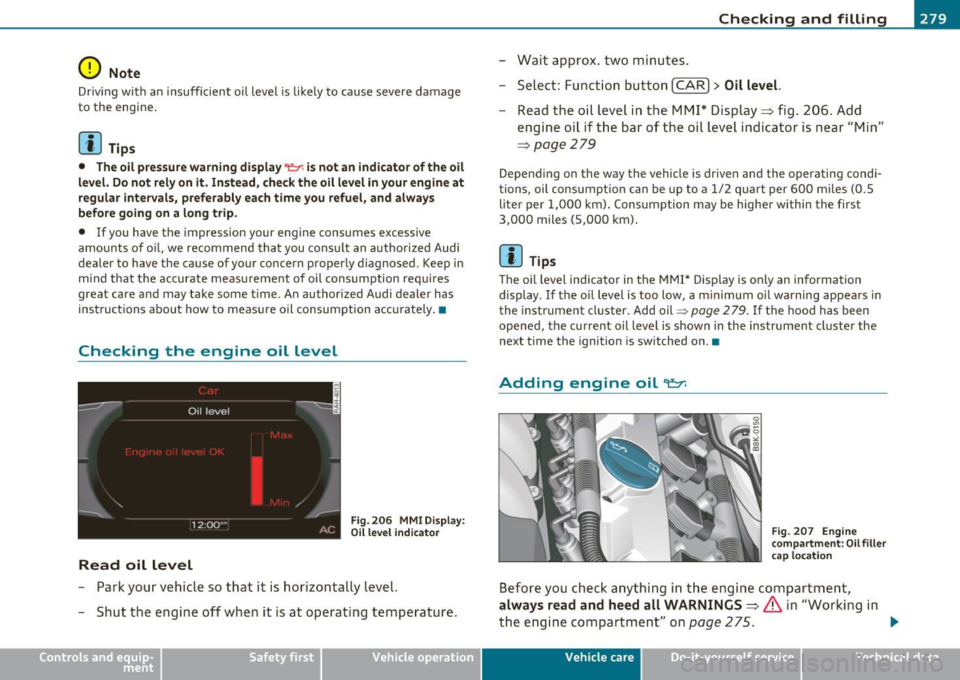
___________________________________________ C_ h _ e_c _k _ i_n -=g ~ a_n _ d_ f_i _ll _i _ n -=g =--- ......J•
0 Note
Dr iv ing with an insufficient oil level is likely to cause severe damage
to the engine .
[ i ] Tips
• The oil pressure warning display~ is not an indicator of the oil
level. Do not rely on it. Instead , check the oil level in your engine at
regular intervals, preferably each time you refuel, and always
before going on a long trip .
• If you have the impression your engine consumes excessive
amounts of oil, we recommend that you consult an authorized Audi
dealer to have the cause of your concern properly diagnosed. Keep in
m ind that the accurate measurement of o il consumption requires
great care and may take some time. An authorized Audi dealer has
instructions about how to measure oil consumption accurately .•
Checking the engine oil level
Fig. 206 MMI Display:
Oil leve l ind icator
Read oil level
-Park your vehicle so that it is horizontally level.
- Shut the engine off when it is at operating temperature.
Vehicle OP-eration
-Wait approx . two minutes.
- Select: Function button
[CAR]> Oil level.
- Read the oil level in the MMI* Display => fig. 206. Add
engine oil if the bar of the oil level indicator is near "Min"
=>
page 279
Depending on the way the vehicle is driven and the operating condi
tions, oil consumpt ion can be up to a 1/2 quart per 600 mi les (0.5
liter per 1,000 km). Consumption may be higher within the first
3,000 miles (5,000 km) .
[ i ] Tips
Th e oil level indicator in the MMI* Display is on ly an information
display.
If the oi l level is too low, a m inimum o il warning appears in
the instrument cluster. Add oil=>
page 2 79. If the hood has been
opened, the current oil level is shown in the instrument cluster the
next time the ignition is switched on .•
Adding engine oil
com partment: Oil filler
cap location
Before you check anything in the engine compartment,
always read and heed all WARNINGS=> & in "Working in
the engine compartment" on
page 275. .,,_
Vehicle care Do-it-yourselt service iTechnical data
Page 283 of 362
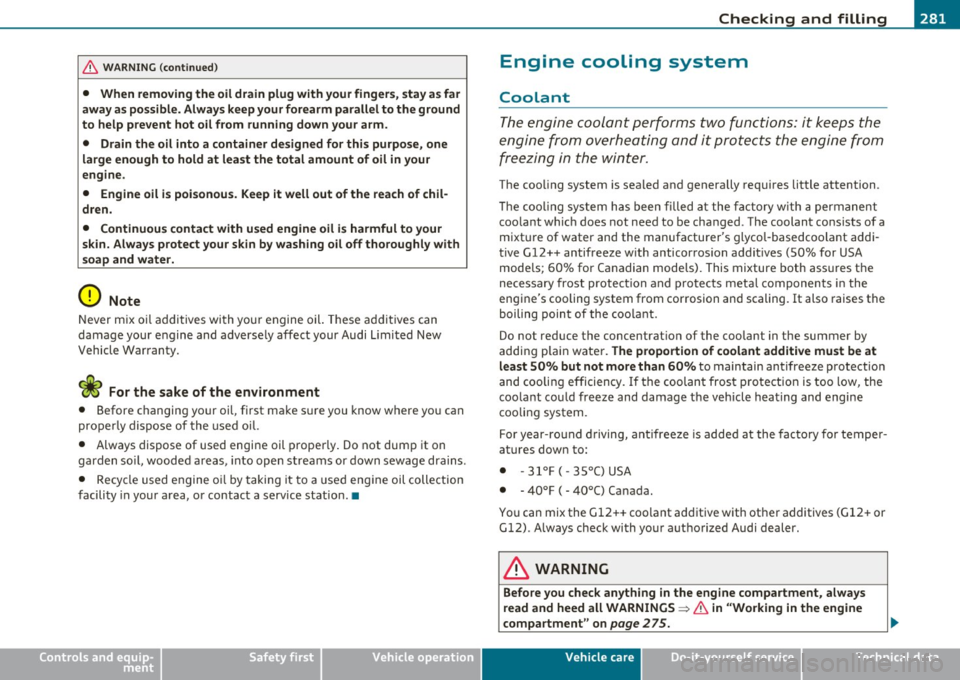
___________________________________________ C_ h_e _c _k_ i_n ~g_ a_n_ d_ f_ i_ll _i_n _g __ _
& WARNING (co ntinued )
• When removing the oil drain plug w ith your fingers , sta y as far
away as possible . Alway s keep your forearm parallel to the ground
to help p revent hot oil from running down your arm.
• Drain the oil into a container de signed for this purpose, one
large enough to hold at least the total amount of oil in your
engine .
• Engine oil is poisonous. Keep it well out of the reach of chil
dren.
• Continuous contact with u sed engine oil is harmful to your
skin. Always protect your skin by washing oil off thoroughly with
soap and water.
0 Note
N ever mix o il additives wi th you r engine oil. These a dditives can
damage your engine and adversely affect your Audi L imited New
Vehicle Warranty.
ffi For the sake of the environment
• Before changing your oil, first ma ke s ure you know w here yo u can
prope rly dispose of the used o il.
• Always dispose of used engine oil properly . Do not dump it on
garden so il, wooded areas , into open streams or down sewage drains .
• Recy cle used e ngine o il by taking it to a used eng ine oil colle ction
facili ty in your area, or contact a service statio n.•
Safety first
Engine cooling system
Coolant
The engine coolant performs two functions: it keeps the
engi ne f rom over heat in g and it prote cts the engine fro m
free zing in the winter .
The coo ling system is sealed and generally requires little attention.
Th e cool ing sys tem h as been filled a t the f actory w ith a permanent
coo lant wh ic h does not need to be changed . The coolant consists of a
mi xtu re of water and the manufacturer 's glyco l-basedcoo lant add i
t ive Gl2++ antifreeze w ith anticor ros ion addit ives (50% for USA
mode ls ; 60% for Ca nadian mode ls). This mixture both ass ures the
necessa ry frost protect ion and p rotects meta l components in the
engine's cooling system from corrosion and scaling. It also raises the
boiling poin t of the coo lant.
Do not red uce the concentrat io n of the coolant in t he summer by
adding p lain wate r. The proportion of coolant additive must be at
least 50 % but not more than 60 %
to maintain antifreeze protection
and coolin g efficiency. If the coolan t fros t pro tection is too low , the
coo la nt cou ld freeze and damage t he veh icle heat ing and engine
cooling system .
For year-ro und d riving, a ntifree ze is adde d at the fac to ry fo r tempe r
atures down to:
• - 31°F(-3 5°C) USA
• -40°F ( -40°() Canada.
Yo u can mix the Gl2 ++ coo lant add itive with other additives (G12 + or
Gl2) . A lways check wi th yo ur auth o rized Audi dealer .
& WARNING
Before you check anything in the engine compartment, always
read and heed all WARNINGS =>
& in "Working in the engine
compartment " on
page 275.
Vehicle care Technical data
Page 284 of 362
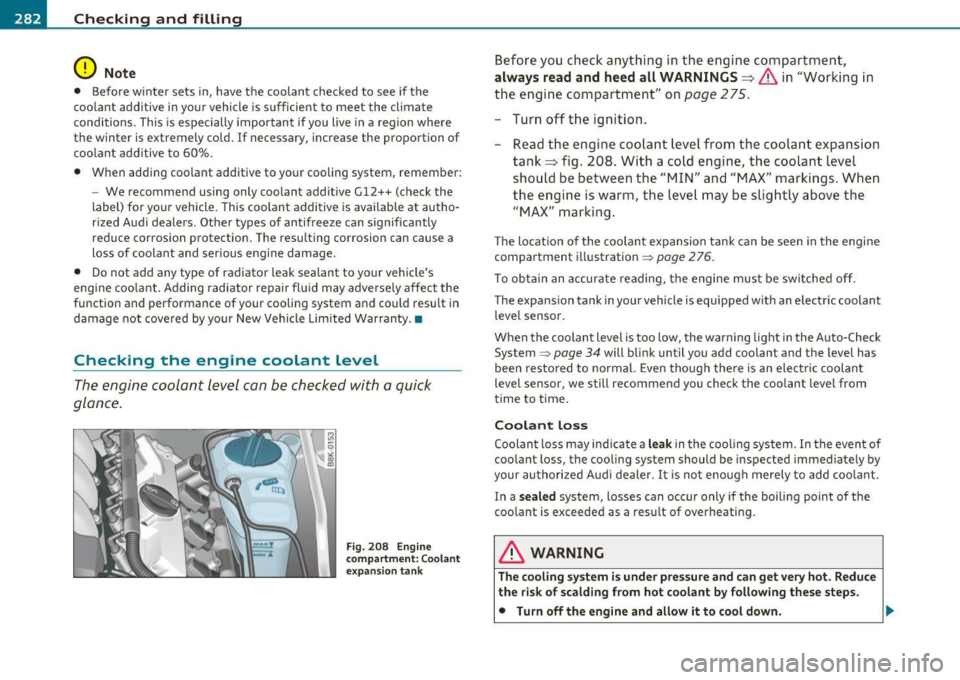
___ C_h_ e_c _k _i_n -=g :a,__ a_n_ d_ f_ i_ l _li _n _,g;._ __________________________________________ _
0 Note
• Before w inter sets in, have the coolant checked to see if the
coolant additive in your vehicle is sufficient to meet the climate
conditions. This is especially important if yo u live in a region where
the winter is extremely cold.
If necessary, increase the proportion of
coolant additive to 60% .
• When adding coolant additive to your cooling system, remember :
- We recommend using only coolant additive G12++ (check the
label) for your vehicle. This coolant additive is available at autho
r iz ed Audi dealers. Other types of antifreeze can s ignificantly
reduce corrosion protection. The resulting corrosion can cause a
loss of coolant and serious engine damage.
• Do not add any type of radiator leak sealant to your vehicle 's
engine coolant. Adding radiator repair flu id may adversely affect the
function and performance of your cooling system and cou ld result in
damage not covered by your New Vehicle Limited Warranty .•
Checking the engine coolant Level
The engine coolant level can be checked with a quick
glance.
Fig. 208 Engine
co mpartment : Coolant
expansion tank
Before you check anything in the engine compartment,
always read and heed all WARNINGS~ & in "Working in
the engine compartment" on
page 275.
-Turn off the ignition.
- Read the engine coolant level from the coolant expansion
tank~ fig. 208 . With a cold engine, the coolant level
should be between the "MIN" and "MAX" markings. When
the engine is warm, the level may be slightly above the
"MAX" marking.
The locat io n of the coolant expansion tank can be seen in the engine
compartment illustration~
page 276.
To obtain an accurate reading, the engine must be switched off.
The expansion tank in your vehicle is equipped with an electric coolant level sensor.
When the coolant level is too low, the warning light in the Auto-Check
System =>
page 34 will blink until you add coolant and the level has
been resto red to normal. Even though there is an electric coolant
level sensor, we still recommend you check the coolant level from
time to time.
Coolant loss
Coolant loss may indicate a leak in the coo ling system. In the event of
coolant loss, the cooling system should be inspected immediately by
your authorized Audi dealer. It is not enough merely to add coolant.
In a
sealed system, losses can occur only if the boiling point of the
coo lant is exceeded as a result of overheating .
& WARNING
The cooling system is under pressure and can get very hot. Reduce
the risk of scalding from hot coolant by following these steps.
• Turn off the engine and allow it to cool down.
Page 348 of 362
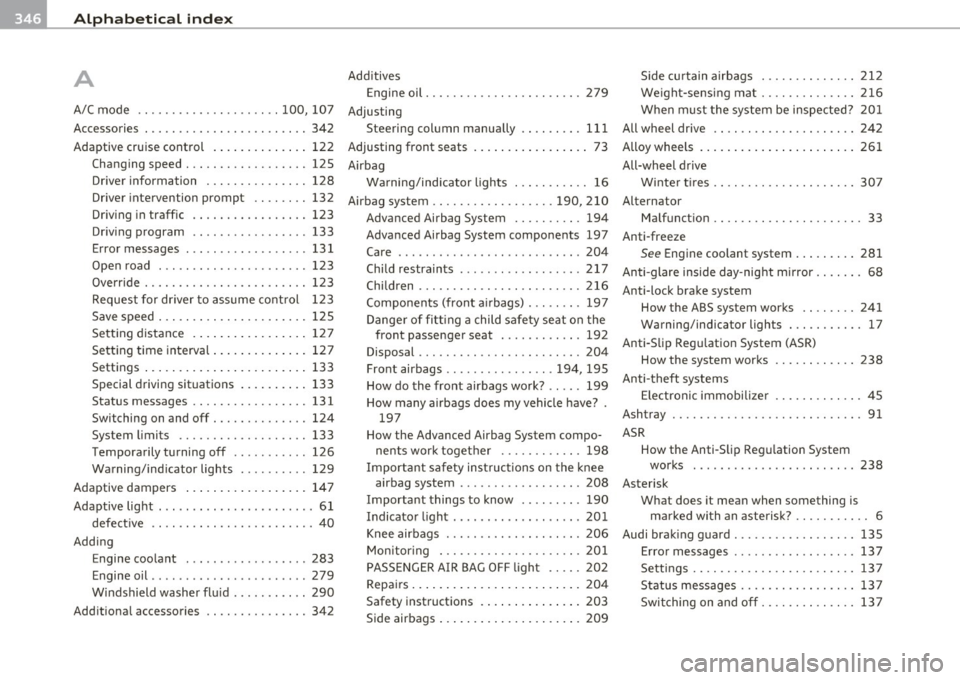
___ A_ l_. p_ h _ a_b_ e_ t_ic _a_ l_ in_ d_e _ x ____________________________________________ _
A Additives
Engine oil .......... .. .. .. .. .. ... 279
A/C mode ................. .. .. 100, 107
Adjusting
Accessories ... .. ..... ....... ....... 342 Steering column manually .. .. .. .. . 111
Adaptive cruise control .............. 122 Adjusting front seats ......... .. .. .. .. 73
Changing speed . .. ...... ......... 125
Airbag
Driver information ............. .. 128
Warning/indicator lights ..... .... .. 16
Driver intervention prompt ...... .. 132
Airbag system .. ................ 190, 210
Driving in traffic .. .. ... ... .... ... 123
Advanced Airbag System ......... . 194
Dr iving program .. .. .. ... ........ 133
Advanced Airbag System components 197
Error messages . . . . . . . . . . . . . . . . . . 131
Care ............... ........ ... . 204
Open road ...... ... ............. 123
Child restraints ... ... ... .. .. .. .. . 217
Override ................ ...... .. 123
Children ....... .. .... .... .. ..... 216
Request for driver to ass ume control 123
Components (front airbags) . .. .... . 197
Save speed . .. .. .. .. .. .. ......... 125
Danger of fitting a child safety seat on the
Setting distance ................. 127
front passenger seat ............ 19 2
Setting time interva l .............. 127
Disposal .... ... .. ... ... .. .. .. .. . 204
Settings ..................... ... 133
Front airbags .......... ...... 194, 195
Special driving situations .......... 133
How do the front airbags work? ..... 199
Status messages ........ ......... 131
How many airbags does my vehicle have? .
Switching on and off .............. 124 197
System limits ................. .. 133 How the Advanced Airbag System compo-
Temporarily turning off ...... .. ... 126 nents
work together ............ 198
Warning/ind icator lights .......... 129 Important safety
instructions on the knee
Adaptive dampers ... ............... 147
Adapt ive light ... .. .. .. .... ...... ... . 61
defect ive ...... .. .. .... .......... 40 airbag system
........... .. .. .. . 208
Important things to know ........ . 190
Indicator light ...... .. ... ... .. .. . 201
Adding Engine coolant ..... ............. 283
Engine oil ....... ......... ....... 279
Windshield washer fluid ........ . .. 290
Additional accessories .. .. .. ......... 342 Knee airbags
........... .. .. .... . 206
Monitor ing . .. ................. . 201
PASSENGER A IR BAG OFF l ight ..... 202
Repairs ......... .... ..... .. .. ... 204
Safety instructions ........ .. .. ... 203
Side airbags ................... .. 209 Side curtain airbags
............ .. 212
We ight-sensing mat ...... .. .. .. .. 216
When must the system be inspected? 201
All wheel drive .. .. .. .. .. .... ... .. .. 242
Alloy wheels ............ .... ..... .. 261
All-wheel drive
Winter t ires .. .. .... ............. 307
Alternator Malfunction .. .. .. .. .............. 33
Anti-freeze
See Engine coolant system ......... 281
Anti-glare inside day-night mirror ...... . 68
Anti-lock brake system
How the ABS system works ...... .. 241
Warning/indicator lights ........ ... 17
Anti-Slip Regu lation System (ASR)
How the system works
Anti-theft systems 238
Electronic immobilizer ...... .... .. . 45
Ashtray ............... ............ . 91
A5R How the Anti -Slip Regu lation System
works ................. ... .... 238
Asterisk What does it mean when something is
ma rked with an asterisk? . . . . . . . . . . . 6
Audi braking guard .... ....... ... .. .. 135
Error messages .... .... .. .. .. .. .. 137
Settings ........ .. .. .. .. .. .. .. .. 137
Status messages ............... .. 137
Switching on and off .......... .. .. 137
Page 352 of 362
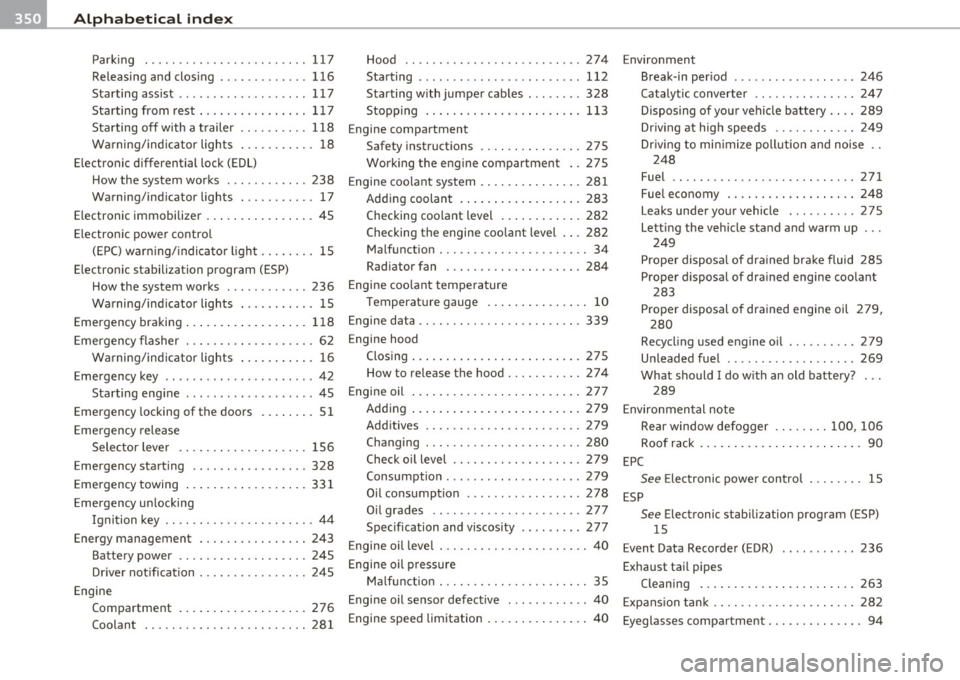
___ A_ l_. p_ h _ a_b_ e_ t_ic _a_ l_ in_ d_e _ x ____________________________________________ _
Parking ........ ..... .. .. .... ... 117 Hood .. .. .. .. .. .... ... . ... .. .. . 274
Releasing and clos ing .. .. ......... 116 Starting ........... .. .. .. ....... 112
Starting assist ................ ... 117 Sta rting with jumpe rr cab les ........ 328
Starting from rest . .. ...... ..... .. 117 Stopp ing ... .. ..... .... .. .. .. .. . 113
Sta rting off w ith a t railer ... . .. .. .. 118
Engine compartment
W arning/ind icator lights . .......... 18
Safety instruct ions .... .. .. .. .. ... 275
Elect ronic differential lock (EDL) Working the eng ine compartment . . 275
How the system works .... ... .. ... 238
Engine coo lant system . .. ... . ... .... . 281
Warning/ind icator lights . .......... 17
Adding coolant ... .... .. . .. ... .. . 283
Electronic immobilizer .. .. . ... ... .. ... 45
Checking coo la nt level . ..... ..... . 282
Electro nic powe r contro l Checking the engine coo
lant level . .. 282
( E PC) war ning/ indicato r light .. ...... 15 Ma
lfunction ... ................. .. 34
Electronic stabilization program (ESP) Radiator fan ...
...... .. .. .. .. ... 284
How the system works ............ 236 Engine coo
lant temperature
Wa rning/ind icator lights . .......... 15 T
emperat ure gauge . .... . ... .. .. . . 10
Emergency braking ..... .. .. .. .. .. ... 118 Engine data
... ... ...... ... .. .. .. .. . 339
Emergency flasher . . . . . . . . . . . . . . . . . . . 62
Engine hood
W arning/ind icator lights ... .. ... ... 16 Closing ........
...... ...... ..... 275
E mergency key .. ................ .... 42 How to re
lease the hood .......... . 2 7 4
Starting eng ine . .. .... .. ..... ..... 45 Engine oil
.... ..... ..... .... .. .. .. . 277
Emergency locking of the doors . ... .. .. 51 Adding ...
... .... .... .... ... . ... 279
Eme rgency release
Sele ctor leve r ............. .... .. 156 Add
itives ...... .. .. .. ...... .. ... 279
Changing ............ .... .. ..... 280
E mergency starting .. .. ... ....... ... 328
Emergency towing ..... .. .. ..... .... 331
Emergency u nlocking
Ignition key .. .... ............. ... 44
Energy management .......... .... .. 243
Battery power ................... 245
Dr iver not ification ..... .. .. ... .. .. 245 Check o
il level ............ .. .... . 279
Consumption ....... .. .. .. ....... 279
Oil consumption .... .... . ... .. .. . 278
Oi l grades .. ..... ............. .. 277
Specification and viscosity .. .. .. .. . 277
E ngine oil leve l ... .... ............. .. 40
E ngine oil pressure
M al fun ctio n ... ........... ...... .. 35
Engine
Compartment .. .. .. .. . ... ... .. .. 276
Coolant ...... .......... ...... .. 281 Engine oil sensor defec
tive ..... .. .. ... 40
Engine speed limitatiorn . ....... ..... .. 40 Environment
Break-in per iod ......... ... .. .. .. 246
Catalytic converte r ............... 24 7
Disposing of you r vehicl e battery .. .. 289
Dr iv ing at hig h speeds ............ 249
Dr iv ing to mi nimize poll ution and noise ..
248
Fuel .. .. .... ............. ...... 271
Fuel economy .. .... .... ... .. .. .. 248
Leaks under you r vehicle ... .. ... .. 275
Lett ing the vehicle stand and warm up ...
249
Proper disposa l of dra ined brake fluid 285
Proper disposal of d ra ined engine coo lant
283
Proper disposal of drained engine oil 279,
280
Recycl ing used e ng ine o il ... .. .. .. . 279
Unleaded fue l ............ ... .. .. 269
What should I do w it h an old batte ry?
289
E nvironmen tal note
Re ar w indow defogger ...... .. 100, 1 06
Roo f rack . . . . . . . . . . . . . . . . . . . . . . . . 90
EPC See Elect ronic power con tro l ........ 15
ESP See Electronic stabilization program (ESP)
15
Event Data Recorde r (EDR) 236
Exhaust tai l pipes
Cleaning ... .... ... .. . .... .... .. 263
E xp ans ion tank .. .. .. .. ............. 282
Eyeglasses compartment ......... . ... . 94